More than a pink font: Selling to women

Women tend to live longer, run a bigger risk of outliving their savings, and might earn less than their male counterparts in their lifetime. Women also are likely to have spent fewer years than men in the workforce due to shouldering childcare responsibilities. Even though they control one-third of total U.S. household financial assets, women sometimes forget to protect their own financial needs or adequately value their work.
The data speaks for itself:
» Women in the U.S. are projected to control much of the $30 trillion in financial assets that baby boomers possess.
» Women are the largest beneficiaries of the current transfer of wealth, living an average of five years longer than men.
» Women are increasingly moving the markets and influencing money, with the percentage of director roles they hold on boards of S&P 500 companies at an all-time high.
Too often, female clients come to the financial planning table during a pivotal or unexpected life change — seeking a relationship with an advisor when they experience the death of a spouse or end of a marriage. As financial professionals who believe all customers deserve a sense of security and freedom, we believe this is unacceptable.
There are many ways we can provide protection solutions that fit into women’s lives and help achieve their goals — for their livelihood, their retirement or their family’s future. Together, we can help close the gap and make real protection possible for more women, so they can achieve the security, freedom and impact they desire.
Building awareness
Although women appreciate data, humans are hard-wired to respond with the amygdala — the emotional processing center of the brain. To better reach female clients, it is helpful to add context to the data in order to paint a picture of how the solution being offered will impact their future. Many advisors fall short by presenting only numbers and neglecting how those numbers will impact the client personally. Women don’t only want to know how much money is in the account — they want to know what it can do for them and how it can protect them and those they care for.
Start looking at the big picture with their life goals. Do they want to cashflow their children’s college education? Do they want to retire to a lake house? Or do they simply want to know their family’s future is secure? Leverage the right financial or insurance solutions to achieve their life’s aspirations.
Getting them involved
At least once a year, advisors should sit down with each client and the client’s spouse or partner.
If women rely on their spouse to relay important information to them, it’s time to get women involved directly. No matter who drives the financial planning in the relationship, women should understand what they have in place and where to find it. Suggest both partners attend meetings, and make sure you build a relationship with each of them.
For example, a couple shopping for life insurance decided to wait and think about it. The husband called back a month or so later and moved forward with the process. He later died in a car accident, and his wife spent months in grief and financial agony, not realizing he had taken out a policy that would solve her financial burdens. In desperation, she thought to call right before her home was being foreclosed on to ask whether he had taken out a policy — and we are glad she did.
Whether or not they are the primary contact for financial matters, women should get to know the advisors in their lives — and you should know your female clients as well as their specific priorities and goals.
Investing in learning
Better understanding and solving for women’s specific needs starts with having women in the room. In your organization, how many women are in leadership positions or are involved in developing insurance or retirement solutions?
By having joint meetings, trainings, team calls, etc., men and women can learn from each other to consider all perspectives. Having men as allies, understanding and hearing what women face, and prioritizing their financial strategy accordingly can help your organization stay attuned to how to communicate with women, especially in a crisis.
How many financial professionals or distributors know the three phases women go through following a spouse’s death, and how to communicate with them? Do you know how to address your female client’s life insurance coverage gap? Prioritize training, resources and value-add programs to understand how to sell to women.
Offering the right solutions
From a retirement standpoint, guaranteed lifetime income provides certainty, and annuities can be a very attractive option here. Whether the woman is the breadwinner or not, income certainty is always high on their priority list. Knowing they can rely on a guaranteed income stream to help meet their basic needs will resonate.
Women are often more risk adverse, which can impact their portfolio’s growth potential. Educating them on the difference between risk tolerance and risk capacity is important to help them achieve their goals. While this is a general rule of thumb for all retirement programs, women especially appreciate knowing what their money is doing for them.
We know women are grossly underinsured when it comes to life insurance. This means we must focus our efforts on myth-busting and helping them understand how important it is to prioritize. For example, women who work inside the home might assume they don’t bring value if they are not bringing in a paycheck, but this is untrue. They should consider the value of their efforts with childcare and keeping their home running. How much would these tasks cost if they were to be outsourced?
Most women will likely outlive their spouses and may take care of their husbands in later years. But who will take care of them? Evaluating a long-term care rider is crucial, especially considering the toll taking care of an aging spouse can have on someone’s health.
As advisors doing what’s right for our clients, we should prepare them for financial success as they age. It’s our role to guide people to the right solutions and make it as easy as possible by improving their quality of life to help ensure all futures are protected.
Martha Hart is a vice president, national sales manager of the retirement division at Protective. She may be contacted at [email protected]. Erika Williams is a vice president, national sales director for insurance at Protective. She may be contacted at [email protected].






Brokers step up to help address rising health care costs
Offer your clients retirement income insurance with annuities
Advisor News
- CFP Board announces CEO leadership transition
- State Street study looks at why AUM in model portfolios is increasing
- Supreme Court to look at ERISA rules in upcoming Cornell case
- FPA announces passing of CEO, succession plan
- Study: Do most affluent investors prefer a single financial services provider?
More Advisor NewsAnnuity News
Health/Employee Benefits News
- New behavioral health clinic focusing on rural communities opens doors in Mankato
- Nebraska senators Brian Hardin, Mike Jacobson pitch Unicam bills on federal help for rural health care
- Jacobson, Hardin pitch Unicam bills on help for rural health care
- State Comptroller's audit reveals $16.2 million in improper Medicaid claim payments
- Recent Research from University of the North Highlight Findings in Opioids (Long-term Opioid Therapy and Risk of Opioid Overdose By Derived Clinical Indication In North Carolina, 2006-2018): Opioids
More Health/Employee Benefits NewsLife Insurance News
- Top 8 trends that will impact insurance in 2025
- 59% of insurance sector breaches caused by third-party attacks.
- Pacific Life Announces Promotions of Karen Neeley and Patricia Thompson to Senior Vice President
- Lincoln Financial Reports 2024 Fourth Quarter and Full Year Results
- 2024 Annual Information Form
More Life Insurance News